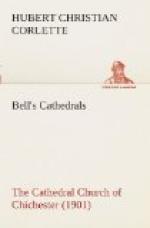At the time these words were written the north porch was in a wrecked condition. Both gables of the transept were in ruins, and the high-pitched roofs of the old library, the lady-chapel, and the south arm of the transept were absent altogether.
But soon the authorities began to take some interest in the condition of the building. James Elmes had been called in to deal with the spire in 1813-1814, and under his direction the “useful piece of machinery” which had been put there by Wren was “taken down and reinstated.” In his “Life of Wren” an illustration is given of the device, which he had carefully examined and measured. He describes it thus:
“To the finial is fastened a strong metal ring, and to that is suspended a large piece of yellow fir-timber eighty feet long and thirteen inches square; the masonry at the apex of the spire, being from nine to six inches thick, diminishing as it rises. The pendulum is loaded with iron, adding all its weight to the finial, and has two stout solid oak floors, the lower one smaller by about three, and the upper one by about two and a quarter inches, than the octagonal masonry which surrounds it. The effect in a storm is surprising and satisfactory. While the wind blows high against the vane and spire, the pendulum floor touches on the lee side, and its aperture is double on the windward: at the cessation, it oscillates slightly, and terminates in a perpendicular. The rest of the spire is quite clear of scaffolding. This contrivance is doubtless one of the most ingenious and appropriate of its great inventor’s applications.”
About 1814 T. King made a plan of the whole building and several drawings of the church as it then appeared. One of these [25] shows some carefully copied specimens of the decorations on the vaults. The engraving was published in 1831, and on it is the statement, “Painted 1520. Erased 1817.” Another drawing showed the interior of the choir looking west. In this was represented in careful detail the design of the eastern elevation of the organ-case and the “return” stalls against the Arundel screen. It also shows the original iron gates in the archway, which pierced the screen in the centre below the organ, and formed the entrance to the choir. These gates were evidently copied in design from the thirteenth-century iron screen that protected the sanctuary, part of which is now in the Victoria and Albert Museum. In the distance the decoration on the nave vaulting is lightly indicated. There




